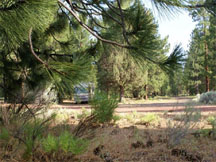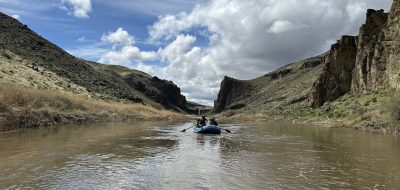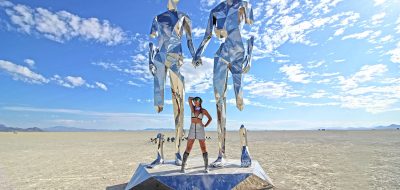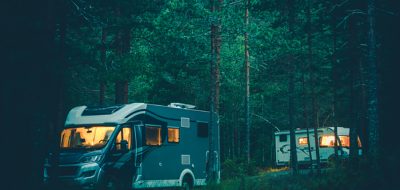By Bob Difley
 In Part 1 last week I wrote about the basics of finding one night boondocking sites when on the road in unfamiliar territory by having the Forest Service and BLM providing some help and information.
In Part 1 last week I wrote about the basics of finding one night boondocking sites when on the road in unfamiliar territory by having the Forest Service and BLM providing some help and information.
This week is about finding campsites when this help is not available, and you are trying to find a scenic, private, and quiet boondocking campsite in a place where you have never camped before.
Both Part 1 and Part 2 are from my ebook, BOONDOCKING: Finding the Perfect Campsite on America’s Public Lands.
Since you are on the road with an ultimate destination or tight timetable, the ideal spot would be one not too far off the main road (which in national forests and on BLM land would be a quiet two-lane road, not a major noisy freeway), and with a large turning radius so that you do not have to unhitch just for one night. That is the trick. I have found the following to be the best—and easiest—way to find a spot with a minimum of fuss and lost time.
First, we slow down so that we don’t sail right on by a likely campsite. I watch one side of the road and Lynn the other. When one of us spots a side road, we slow down and pull off to the side of the road and walk down the road for a couple hundred yards (we’re usually due for a leg stretcher by this time and welcome the walk) to see if we can find a likely spot. If so, we retrieve our rig and settle in. We have found good campsites along most of our regularly traveled routes and those spots become daily destinations while enroute.
If we can’t find a suitable spot from the above search, and if we find the area particularly scenic, we may walk further in, or go back and unhitch our toad and drive in a ways hoping to find a good spot (you may not want to go to this step if you are towing a trailer or fifth-wheel). But we don’t take too long for the search. If we find nothing , we return, but don’t hitch up again, and continue on down the road with Lynn taking the lead looking for another side road. When she pulls over, I follow, park the motorhome, and jump in the car and off we go to look for another spot.
Usually following this procedure we will find something in short order. However, we have been in new territory where we could not quickly find a suitable campsite. This will happen, but only once the first time you go through an area. This factor would become part of your notes for next time. Our backup—and sometimes our primary choice—would be to first locate any designated campgrounds in the area we are passing through so that if we don’t find a spot we head for one of them, or if we pass one, check it out before continuing.
Often, if there are forest service campgrounds in the area we will head there first, as they are among our favorite campgrounds and are inexpensive, ranging from $0 if there is no water or other amenities, to seldom as much as $20/night (which with our Interagency Senior or Annual Pass [see Federal Recreation Passes below] will cost us half that).
For Class B, Class C, small motorhome, and truck camper users that are not towing it is safe enough to drive down the access road as long as you make sure that you can see far enough ahead to determine whether there are any obstacles, such as fallen trees, rock slides, low overhanging branches, and washouts that could hinder turning around. Or grazing cattle (yes, the NFS and BLM grant grazing permits and you might not like the smell of cattle in your campsite).
Sometimes you can spot campsites from the road. Along rivers or streams where the paved road crosses are good places to look for campsites that anglers have previously established. Those of you that are towing travel trailers or fivers, though you have a bit more flexibility in backing up and turning around than a motorhome with a toad, it is probably best to park on the side of the road and walk in to check for a spot rather than unhitch and have to hitch up again if you find nothing.
And now a request. To those of you who have purchased the Amazon/Kindle version of my BOONDOCKING: Finding the Perfect Campsite on America’s Public Lands book–and hopefully liked it and found it useful–I would greatly appreciate if you would post a short review on the book’s Kindle page. Reviews from readers help others decide whether the book will fit their needs, and readers’ comments are often relied upon more than what the author says. So if you post a review, I thank you.
For more RVing tips take a look at my Healthy RV Lifestyle website, where you will also find my ebooks: BOONDOCKING: Finding the Perfect Campsite on America’s Public Lands (PDF or Kindle), 111 Ways to Get the Biggest Bang for your RV Lifestyle Buck (PDF or Kindle), and Snowbird Guide to Boondocking in the Southwestern Deserts (PDF or Kindle).







Julianne G Crane
We are currently traveling cross country and are mostly staying only one night in each location. My primary resource is “Guide to Free Campgrounds” 14th Edition by Don Wright. I prefer this paperback book, because frequently we are in places without Internet connection. Hugely valuable.
marianj`
All this is good advice. We have used Walmart and found some very noisy. Also we parked at a country church and gave a donation. We did ask if it was okay. Most truck stops are noisy also. We found a nice free spot north of Quartsite AZ. Free in the desert. You can camp 14 days It is only 30 minutes from town.
Barbara Palmer
Another option is Harvest Hosts (harvesthosts.com) – farms, wineries, fruit stands that have room for an RV to park overnight and welcome members to stay for up to 24 hours. Dry camping, membership (cheap) required, but you get a quiet place to stay and the opportunity to support local agriculture. Many of the hosts are within a short distance of interstates, others are more remote. We’ve thoroughly enjoyed our membership, and have met many interesting and friendly people.
Nick Baker
My wife and I just returned from a three week boondocking trip to the western USA. We camped mainly in BLM and or National Forest, one night at a time. We have a GPS that list these areas and we had no problem locating a place to stay for the night.
Nick
Richard McConnell
When we travel from MI to AZ and back we stop overnight at Elk lodges. Some are dry camping and some have full hookups. You can get a beverage and maybe a fishfry or other dinner special. No camping fees but a donation is appreciated and it is tax deductible. The Elks have a website and using the key word RV you can find out which lodges offer overnight camping. Of course membership is required but everyone is friendly and they are glad to see ya when you visit their lodge.
Wayne Harper
If your just passing thru, why not try Wal Marts. We do all the time and we have never had any problems. Some truck stops in the East have a separate areas for buses and RV’s. At the Petro Travel & Truck stop outside Scranton PA, we can even get shore power for $15.
It makes no sense to me to travel very far of the main highways and interstates when most of these options are close to these roads.
Glen Jones
Roger there are national and state forests in most of the East and central states also, get trailer life or woodalls campground directories ( They will be one directory next year) there are also other campground directories available also for Eastern and western States
Dave Stoeffler
Try freecampsites.com
Roger Marble
Lots of good info if you are traveling out West but what about those of us traveling in the East & central states?
I would really like to be able to find low cost ($10 to $20) campgrounds within 10 miles of Interstate exits. It doesn’t make sense to drive 20 or 30 miles each way burning $40 in fuel trying to save. $20 on camping fees.